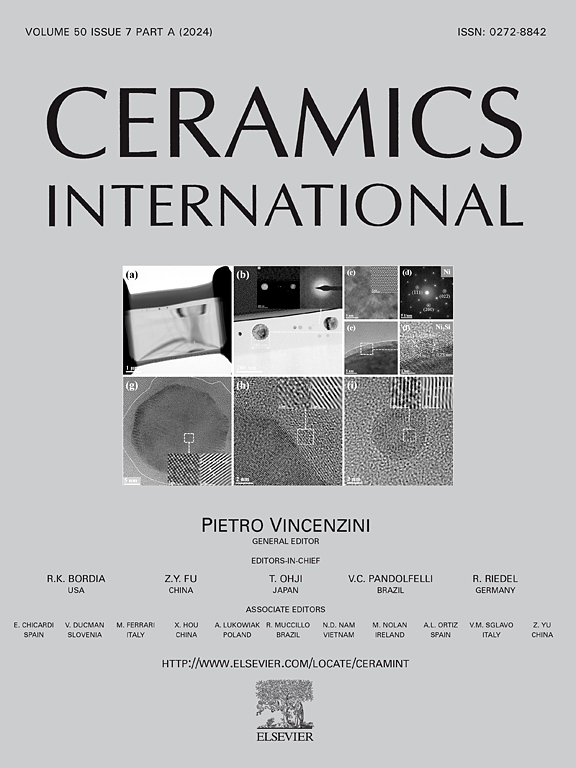Wear and corrosion resistance of cathodic plasma electrolytic deposited Al2O3-ZrO2 composite ceramic coatings on sintered NdFeB magnet
IF 5.1
2区 材料科学
Q1 MATERIALS SCIENCE, CERAMICS
引用次数: 0
Abstract
To enhance the wear and corrosion resistance of the sintered NdFeB magnet, Al2O3-ZrO2 composite ceramic coatings were fabricated using cathodic plasma electrolytic deposition (CPED) technique. The effect of zirconium sulfate concentrations on the microstructure and properties of the coatings were investigated. The composite ceramic coatings are mainly composed of γ-Al2O3 and t-ZrO2 phases, and the volume fractions of t-ZrO2 phase gradually increase with increasing the concentrations of zirconium sulfate. At the same time, the surface morphologies of the coatings change from coral reef-like structure to pan-like structure. Furthermore, the negative influence of the composite ceramic coatings on the magnetic properties of the NdFeB magnet also gradually diminishes. The composite ceramic coatings enhance the microhardness of the NdFeB magnet by 1.76 times, and substantially reduce the friction coefficient and wear rate, thereby improving its wear resistance. Concurrently, the composite coatings greatly improve the sulfuric acid immersion corrosion and electrochemical corrosion of the magnet. This paper provides a new protection strategy for the sintered NdFeB magnets.

求助全文
约1分钟内获得全文
求助全文
来源期刊

Ceramics International
工程技术-材料科学:硅酸盐
CiteScore
9.40
自引率
15.40%
发文量
4558
审稿时长
25 days
期刊介绍:
Ceramics International covers the science of advanced ceramic materials. The journal encourages contributions that demonstrate how an understanding of the basic chemical and physical phenomena may direct materials design and stimulate ideas for new or improved processing techniques, in order to obtain materials with desired structural features and properties.
Ceramics International covers oxide and non-oxide ceramics, functional glasses, glass ceramics, amorphous inorganic non-metallic materials (and their combinations with metal and organic materials), in the form of particulates, dense or porous bodies, thin/thick films and laminated, graded and composite structures. Process related topics such as ceramic-ceramic joints or joining ceramics with dissimilar materials, as well as surface finishing and conditioning are also covered. Besides traditional processing techniques, manufacturing routes of interest include innovative procedures benefiting from externally applied stresses, electromagnetic fields and energetic beams, as well as top-down and self-assembly nanotechnology approaches. In addition, the journal welcomes submissions on bio-inspired and bio-enabled materials designs, experimentally validated multi scale modelling and simulation for materials design, and the use of the most advanced chemical and physical characterization techniques of structure, properties and behaviour.
Technologically relevant low-dimensional systems are a particular focus of Ceramics International. These include 0, 1 and 2-D nanomaterials (also covering CNTs, graphene and related materials, and diamond-like carbons), their nanocomposites, as well as nano-hybrids and hierarchical multifunctional nanostructures that might integrate molecular, biological and electronic components.
 求助内容:
求助内容: 应助结果提醒方式:
应助结果提醒方式:


